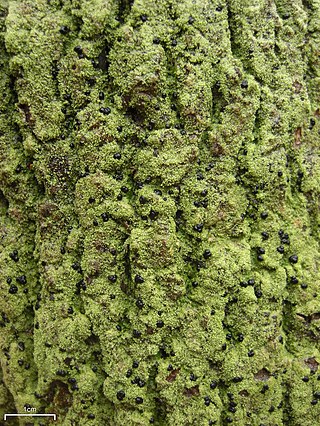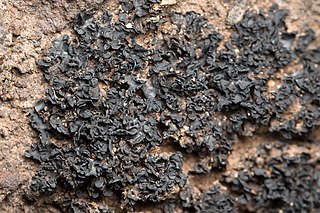
Bacidia is a genus of lichen-forming fungi in the family Ramalinaceae. The genus was circumscribed by Giuseppe De Notaris in 1846.

The Lichinaceae are a family of ascomycete fungi. Most species are lichenized with cyanobacteria, and have a distribution largely in temperate regions.

Thelidium is a genus of lichen-forming fungi in the family Verrucariaceae. The genus was circumscribed in 1855 by Italian lichenologist Abramo Bartolommeo Massalongo, who assigned Thelidium amylaceum as the type species.

Lichinella is a genus of lichen-forming fungi in the family Lichinaceae. It was circumscribed in 1872 by Finnish lichenologist William Nylander. Five species are accepted by Species Fungorum.

Peccania is a genus of lichenized fungi within the family Lichinaceae. As of July 2023, Species Fungorum accepts five species of Peccania, although many more species have been placed in the genus.
Psorotichia is a genus of lichen-forming fungi in the family Lichinaceae. The genus was circumscribed by Italian lichenologist Abramo Bartolommeo Massalongo in 1855, with Psorotichia murorum assigned as the type species.
Pterygiopsis is a genus of fungi within the family Lichinaceae. It contains 11 species.

Pyrenopsis is a genus of lichen-forming fungi in the family Lichinaceae. It contains 12 species. The genus was circumscribed by the Finnish lichenologist William Nylander in 1858.
Zahlbrucknerella is a genus of filamentous, rock-dwelling lichens in the family Lichinaceae.

Thyrea is a genus of lichen-forming fungi in the family Lichinaceae. It contains four species that have been accepted by Species Fungorum. The genus was circumscribed by Italian lichenologist Abramo Bartolommeo Massalongo in 1856, with Thyrea plectospora assigned as the type species.

Gyalecta is a genus of lichen-forming fungi in the family Gyalectaceae that contains 50 species. Gyalecta was circumscribed by lichenologist Erik Acharius in 1808. It forms associations with Trentepohlia algae.
Poeltiaria is a genus of lichen-forming fungi in the family Lecideaceae. It was circumscribed in 1984 by lichenologist Hannes Hertel, with Poeltiaria turgescens assigned as the type species.

Rhizocarpon is a genus of crustose, saxicolous, lecideoid lichens in the family Rhizocarpaceae. The genus is common in arctic-alpine environments, but also occurs throughout temperate, subtropical, and even tropical regions. They are commonly known as map lichens because of the prothallus forming border-like bands between colonies in some species, like the common map lichen.

Catillaria is a genus of crustose lichens in the family Catillariaceae. The genus was circumscribed by Italian lichenologist Abramo Bartolommeo Massalongo in 1852. It is the type genus of Catillariaceae, which was circumscribed by Austrian lichenologist Josef Hafellner in 1984.
Lempholemma polycarpum is a little-known species of saxicolous (rock-dwelling) lichen in the family Lichinaceae. It was first described from Yemen and is characterised by its blackish thallus, abundant small apothecia, and cyanobacteria from the genus Nostoc as its photobiont. The lichen is found on inclined limestone boulders in sun-exposed habitats with open forest vegetation. It also occurs in Madagascar and in Aldabra.

Peccania tiruncula is a species of saxicolous (rock-dwelling), squamulose to dwarf fruticose lichen in the family Lichinaceae. It was first described as a new species in 1878 by the Finnish lichenologist William Nylander, who classified it in the genus Omphalaria. The type specimen was collected by Johan Petter Norrlin in Biskra. Aino Henssen transferred it to the genus Peccania in 1990.









